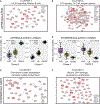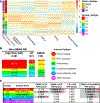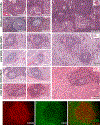Polyclonal lymphoid expansion drives paraneoplastic autoimmunity in neuroblastoma
- PMID: 37537844
- PMCID: PMC10551040
- DOI: 10.1016/j.celrep.2023.112879
Polyclonal lymphoid expansion drives paraneoplastic autoimmunity in neuroblastoma
Abstract
Neuroblastoma is a lethal childhood solid tumor of developing peripheral nerves. Two percent of children with neuroblastoma develop opsoclonus myoclonus ataxia syndrome (OMAS), a paraneoplastic disease characterized by cerebellar and brainstem-directed autoimmunity but typically with outstanding cancer-related outcomes. We compared tumor transcriptomes and tumor-infiltrating T and B cell repertoires from 38 OMAS subjects with neuroblastoma to 26 non-OMAS-associated neuroblastomas. We found greater B and T cell infiltration in OMAS-associated tumors compared to controls and showed that both were polyclonal expansions. Tertiary lymphoid structures (TLSs) were enriched in OMAS-associated tumors. We identified significant enrichment of the major histocompatibility complex (MHC) class II allele HLA-DOB∗01:01 in OMAS patients. OMAS severity scores were associated with the expression of several candidate autoimmune genes. We propose a model in which polyclonal auto-reactive B lymphocytes act as antigen-presenting cells and drive TLS formation, thereby supporting both sustained polyclonal T cell-mediated anti-tumor immunity and paraneoplastic OMAS neuropathology.
Keywords: CP: Cancer; CP: Immunology; IgH; TCRB; ataxia; autoimmunity; immune profiling; myoclonus; neuroblastoma; opsoclonus; paraneoplastic; repertoires.
Copyright © 2023 The Authors. Published by Elsevier Inc. All rights reserved.
Conflict of interest statement
Declaration of interests The authors declare no competing interests.
Figures






References
-
- Ehrlich P (1908). Ueber den jetzigen Stand der Karzinomforschung.
-
- Dalmau J, Armangué T, Planagumà J, Radosevic M, Mannara F, Leypoldt F, Geis C, Lancaster E, Titulaer MJ, Rosenfeld MR, and Graus F (2019). An update on anti-NMDA receptor encephalitis for neurologists and psychiatrists: mechanisms and models. Lancet Neurol. 18, 1045–1057. 10.1016/S1474-4422(19)30244-3. - DOI - PubMed
Publication types
MeSH terms
Substances
Grants and funding
LinkOut - more resources
Full Text Sources
Medical
Molecular Biology Databases
Research Materials
Miscellaneous

